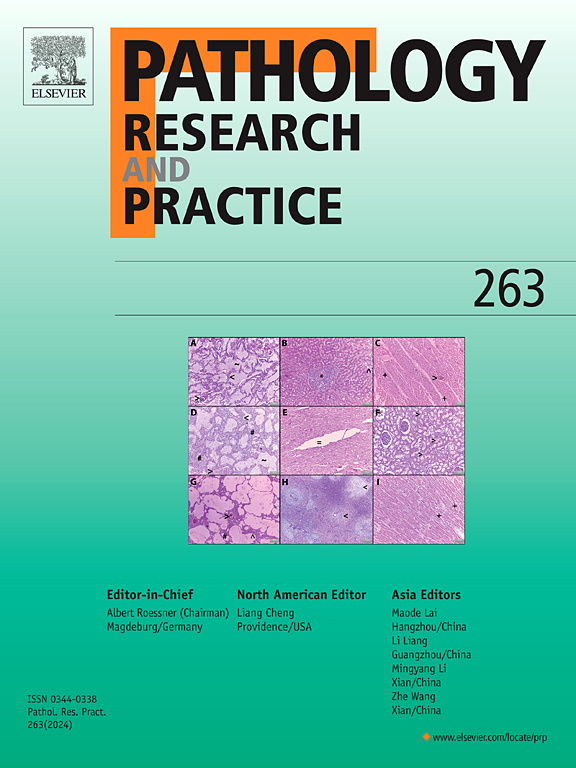Estrogen receptor conversion in bone, liver and lung metastases from breast cancer
IF 3.2
4区 医学
Q2 PATHOLOGY
引用次数: 0
Abstract
Breast cancer treatment is dictated by biomarker status which has been documented to convert between primary tumor and metastases, potentially altering patient management. We investigated breast biomarker conversion in metastases to bone, liver, and lung and its correlation with clinicopathologic factors, prognosis and genetic alterations. Within our cohort of bone (n = 35), liver (n = 20), and lung (n = 13) metastases, there was no significant differences in age at initial diagnosis, sex, laterality, tumor type, and tumor grade of primary tumors. Primary tumors that metastasized to bone and liver had higher ER positivity and intensity as well as more PR positivity than those that metastasized to the lung. Fifteen percent (15 %) of our population (10 out of 68 cases) demonstrated ER conversion, most frequently in liver (35 % in liver vs. 5.7 % in bone, 7.7 % in lung; p < 0.01). Of these, 7 cases converted from positive to negative while 3 (all liver metastases) converted from negative to positive. Cases with any ER conversion were found to have a significantly shorter median survival compared to non-converted cases (12 vs. 38 months; p < 0.0001). We also found TP53 mutations in 2 of 3 cases with conversion from negative to positive and PIK3CA mutations in 4 of 6 cases with conversion from positive to negative. Our study demonstrated that the liver is a metastatic site with a higher chance for ER conversion than bone and lung, and ER conversion from negative to positive is likely to be seen in liver metastasis. Moreover, ER conversions, no matter in which direction, are associated with worse prognosis.
乳腺癌骨、肝和肺转移灶中的雌激素受体转化。
乳腺癌的治疗是由生物标志物状态决定的,生物标志物状态在原发肿瘤和转移瘤之间转换,可能改变患者的管理。我们研究了转移到骨、肝和肺的乳腺生物标志物转化及其与临床病理因素、预后和遗传改变的相关性。在我们的骨转移(n = 35)、肝转移(n = 20)和肺转移(n = 13)队列中,原发肿瘤的初始诊断年龄、性别、侧边、肿瘤类型和肿瘤分级没有显著差异。骨和肝脏转移的原发性肿瘤ER阳性和强度高于肺转移的原发性肿瘤,PR阳性高于肺转移的原发性肿瘤。我们的人群中有15%(15 %)(68例中有10例)表现出ER转化,最常见的是肝脏(肝脏35 %,骨骼5.7 %,肺部7.7 %
本文章由计算机程序翻译,如有差异,请以英文原文为准。
求助全文
约1分钟内获得全文
求助全文
来源期刊
CiteScore
5.00
自引率
3.60%
发文量
405
审稿时长
24 days
期刊介绍:
Pathology, Research and Practice provides accessible coverage of the most recent developments across the entire field of pathology: Reviews focus on recent progress in pathology, while Comments look at interesting current problems and at hypotheses for future developments in pathology. Original Papers present novel findings on all aspects of general, anatomic and molecular pathology. Rapid Communications inform readers on preliminary findings that may be relevant for further studies and need to be communicated quickly. Teaching Cases look at new aspects or special diagnostic problems of diseases and at case reports relevant for the pathologist''s practice.

 求助内容:
求助内容: 应助结果提醒方式:
应助结果提醒方式:


